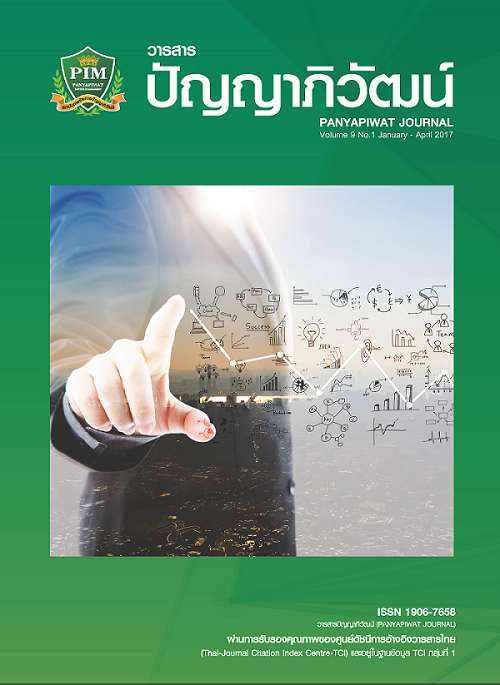ความสัมพันธ์เชิงปรากฏการณ์ของปัจจัยที่ส่งผลต่อความสำเร็จในการจัดการความรู้ของโรงเรียนมัธยมศึกษาขนาดใหญ่พิเศษ สังกัดสำนักงานคณะกรรมการการศึกษาขั้นพื้นฐาน
Main Article Content
บทคัดย่อ
บทความวิจัยนี้มีวัตถุประสงค์ เพื่อศึกษาความสำเร็จในการจัดการความรู้ ความสัมพันธ์เชิงปรากฏการณ์ของปัจจัยที่ส่งผลต่อความสำเร็จในการจัดการความรู้ และสังเคราะห์กระบวนการจัดการความรู้บนพื้นฐานของปัจจัยที่ส่งผลต่อความสำเร็จในการจัดการความรู้ของโรงเรียนมัธยมศึกษาขนาดใหญ่พิเศษ สังกัดสำนักงานคณะกรรมการการศึกษาขั้นพื้นฐาน กลุ่มตัวอย่างที่ใช้ในการศึกษา ได้แก่ ผู้อำนวยการโรงเรียน และรองผู้อำนวยการโรงเรียนมัธยมศึกษาขนาดใหญ่พิเศษ จำนวน 226 คน ใช้เทคนิคการสุ่มกลุ่มตัวอย่างแบบแบ่งชั้น โดยใช้ภูมิภาคเป็นชั้นในการสุ่ม เครื่องมือที่ใช้ในการวิจัย ได้แก่ แบบสอบถามปัจจัยที่ส่งผลต่อความสำเร็จ และระดับผลสำเร็จของการจัดการความรู้ สถิติที่ใช้ในการวิเคราะห์ข้อมูลคือ ค่าเฉลี่ย ส่วนเบี่ยงเบนมาตรฐาน ค่าสัมประสิทธิ์สหสัมพันธ์แบบเพียร์สัน และการวิเคราะห์จำแนกกลุ่ม กลุ่มตัวอย่างที่ใช้ในการศึกษาเชิงคุณภาพ ได้แก่ โรงเรียนที่ประสบความสำเร็จในการจัดการความรู้ขั้นสูง 3 โรงเรียน และโรงเรียนที่ประสบความสำเร็จในการจัดการความรู้ขั้นต่ำ 3 โรงเรียน โดยการสัมภาษณ์ผู้อำนวยการโรงเรียน และรองผู้อำนวยการโรงเรียน เครื่องมือที่ใช้ ได้แก่ แบบสัมภาษณ์แบบมีโครงสร้าง วิเคราะห์ข้อมูลโดยการวิเคราะห์เนื้อหา
ผลการวิจัยพบว่า ปัจจัยที่ส่งผลต่อความสำเร็จและความสำเร็จของการจัดการความรู้ โดยรวมและรายด้านอยู่ในระดับมาก ได้แก่ ปัจจัยด้านภาวะผู้นำของผู้บริหาร ปัจจัยด้านวิสัยทัศน์ผู้บริหาร ปัจจัยด้านโครงสร้างองค์กร ปัจจัยด้านวัฒนธรรมโรงเรียน ปัจจัยด้านความสามารถของบุคลากร ปัจจัยด้านแรงจูงใจในการทำงาน และปัจจัยด้านเทคโนโลยีสารสนเทศ ทุกปัจจัยมีความสัมพันธ์ทางบวก อย่างมีนัยสำคัญทางสถิติที่ระดับ .01 กระบวนการจัดการความรู้ที่ส่งผลต่อความสำเร็จในการจัดการความรู้เริ่มจากปัจจัยวิสัยทัศน์และภาวะผู้นำของผู้บริหาร ซึ่งต้องวางโครงสร้างองค์การให้เป็นระบบ ส่งเสริมวัฒนธรรมโรงเรียนที่เอื้อต่อการจัดการความรู้ พัฒนาความรู้ ความสามารถของบุคลากร สร้างแรงจูงใจในการทำงาน สนับสนุนการใช้เทคโนโลยีสารสนเทศควบคู่ไปกับการบริหารจัดการ มีการวัดผล ประเมินผลการดำเนินงานในทุกขั้นตอน และมีการดำเนินการอย่างจริงจังและต่อเนื่อง
The purpose of this research was for studying the achievement of knowledge management, the relationship between existing situations of factors affecting its success as well as the synthesis process based on all factors being parts of their accomplishment of the specially large-sized secondary schools under the Office of Basic Education Commission. This research was conducted in both quantity and quality aspects. The sample groups used for the first aspect were from the directors and their deputy directors of the specially large-sized secondary schools in the number of 226 people. The technique used for this was Stratified random sampling in level. Each level was separated by the regional area. The tools used in the research were questionnaires involving factors influential in success and the levels of the knowledge management. The statistical tools used for data analysis were the Mean, the Standard Deviation, the Pearson Product Moment Simple Correlation and the Discriminating Analysis. The other sample groups used for the second aspect were from the three successful school in high and three successful in low level of knowledge. The way of getting information was the interviewing their directors and deputy directors. The tools of the second one were the interviewing forms which were analyzed data by content analysis.
The result of research found that the factors influenced the success of knowledge management in some and whole dimensions were rated as high. It comprises of the leadership of the administrators, the structures of organization, the school culture, the personnel efficiency, the inspirations and the information technology. All of the references are related to positive way with statistical significance at .01 level. The procedure of success initiates from the vision and the leadership of the directors who know how to administer their infrastructure systems including with cultural school enhancement, flexible knowledge and potential development as well as some inspirations. Besides studying how to use new technology accompanied by managing administration is essential. At the same time there were continuous and exact measurement and assessment in all steps.
Article Details
“ข้าพเจ้าและผู้เขียนร่วม (ถ้ามี) ขอรับรองว่า บทความที่เสนอมานี้ยังไม่เคยได้รับการตีพิมพ์และไม่ได้อยู่ระหว่างกระบวนการพิจารณาลงตีพิมพ์ในวารสารหรือแหล่งเผยแพร่อื่นใด ข้าพเจ้าและผู้เขียนร่วมยอมรับหลักเกณฑ์การพิจารณาต้นฉบับ ทั้งยินยอมให้กองบรรณาธิการมีสิทธิ์พิจารณาและตรวจแก้ต้นฉบับได้ตามที่เห็นสมควร พร้อมนี้ขอมอบลิขสิทธิ์บทความที่ได้รับการตีพิมพ์ให้แก่สถาบันการจัดการปัญญาภิวัฒน์หากมีการฟ้องร้องเรื่องการละเมิดลิขสิทธิ์เกี่ยวกับภาพ กราฟ ข้อความส่วนใดส่วนหนึ่งและ/หรือข้อคิดเห็นที่ปรากฏในบทความข้าพเจ้าและผู้เขียนร่วมยินยอมรับผิดชอบแต่เพียงฝ่ายเดียว”
เอกสารอ้างอิง
Bennett, J. K. & O’Brein, M. J. (1994). The building blocks of the learning organization. Training, 31(6), 41-49.
Boonyaki, B., Prasopsukchokechai, N. & Pornchanoknart, D. (2005). Knowledge Management from Theory to Practice (2nd ed.). Bangkok: Jirawat Express. [in Thai]
Braun, J. B. (1991). An analysis of principal leadership vision and its relationship to school classmate. Dissertation Abstract International, 52(4), 1139-A.
Chen, L. Y. (2004). An examination of the relationship among leadership behaviors, knowledge sharing and organizations’ marketing effectiveness in professional service firms that have been engaged in strategic alliances. Doctoral dissertation, Business Administration, Graduate School, The Nova Southeastern University.
Chua, A. (2004). Knowledge management system architecture: A bridge between KM Consultants and technologists. International Journal of information Management,24(1), 87-98.
Cooke, R. A. & Lafferty, J. C. (1989). Organizational culture inventory. Michigan: Human Synergistics.
Davenport, T. & Prusak, L. (2000). Working knowledge: How organizations know what they know.Boston: Harvard Business School Press.
Hlupic, V., Pouloudi, A. & Rzevski, G. (2002). Toward an integrated approach to knowledge management: “Hard” “soft” and “abstract”. Knowledge and Process Management, 9(2), 91-102.
Hughes, L. P. & Holbrook, J. D. A. (1998). Measurement knowledge management: A new indicator of innovation in enterprises. Columbia: Simon Fraser University Press.
Jitlung, J. (2007). A Linear Structural Equation Model of Knowledge Management Factors Affecting Learning Organizations in Schools under the Office of Basic Education Commission in Southern Provinces. Degree of Doctor of Education in Educational Administration, Prince of Songkla University. [in Thai]
Klaisubun, A. (2007). Primary knowledge management. Nakornpatom: Kasem Printing group. [in Thai]
Klinngam, S. (2008). Developing a Knowledge Management Model for Rajabhat Universities. Degree of Doctor of Education in Educational Administration, Ramkhamhaeng University. [in Thai]
Marquardt, M. J. (2002). Building the learning organization: A systems approach to quantum improvement and global success. New York: McGraw-Hill.
McClelland, D. E. (1987). Management: Principles and practices. London: Collier- Macmillan.
Muangthong, C. (2014). A pilot-educational interview of Knowledge Management in specially large-sized secondary school. (Mimeographed). [in Thai]
Panich, V. (2003). Academy & Knowledge Management for Society. Bangkok: Pimdee. [in Thai]
Robbins, S. P. (1996). Organizational behavior: Concepts, controversies, applications (7th ed.). London: The MIT Press.
Senge, P. M. (1990). The fifth discipline. London: Century Business.
Sisan, B. (2011). The development of causal structural relationship of factors affected to success of knowledge management in lap schools. Dissertation, Ed.D., Srinakarinwirot University. [in Thai]
Suanpleng, P. (2009). Knowledge Management Model for Developing Rajabhat Universities to a Learning Organization. Office of Academic Resources and Information Technology (ARIT), Suan Dusit Rajabhat University. [in Thai]
The Secretariat of the Senate. (2011). The action plan of knowledge management in academic year of 2011. Bangkok: Senate press. [in Thai]
Titipongvanich, S. (2009). Factors Affecting Knowledge Management of Local Wisdom in Basic Education Schools under the Office of Phetchaburi Educational Service Area 2. Master of Education Thesis in Educational Administration, Phetchaburi Rajabhat University. [in Thai]


